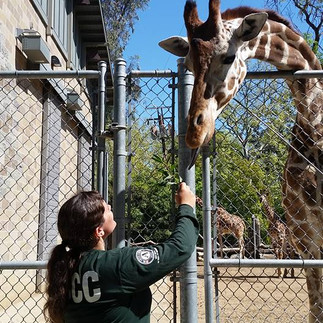One Year in Americorps NCCC: At the Pacific Region
- Sabrina
- Mar 22, 2023
- 11 min read
Thinking about joining AmeriCorps NCCC, but not sure what your year may look like? Hopefully I can give you an idea by breaking down my first year in the Pacific Region.
Program Overview
There is a lot to this program. If you are not familiar with NCCC, here is some information you may need to know in order for everything to make sense.
What is Americorps NCCC
AmeriCorps NCCC (National Civilian Community Corps) is a team-based, residential program for people between the ages of 18 and 26 to dedicate 10-11 months of their lives to national community service. It is also referred to as Traditional Corps.
What to know about the Pacific Region
The USA is divided into four sections to create the different regions of NCCC: Pacific, North Central, Southwest, and Southern. The teams and members belonging to each region will most likely travel to the states within their region for service work.

The Pacific region (as of 2023) is assigned the following states: California, Oregon, Washington, Idaho, Montana, Nevada, Utah, Alaska, and Hawaii. Note: when I was in the program, Wyoming was apart of the Pacific Region. The Pacific region's home base is located in McLenin, California, just outside of Sacramento. The campus itself was once an old airfare base.
The pacific region currently sends their team on 3 different rounds throughout the year. When I was in the program, there were 4 rounds. You can think of a round as the length of time you will be sent on a project before returning to home base. It is possible to have more than one project during a round.
How to apply to the Pacific Region
While you many not be able to specifically apply directly to the campus you are looking to serve on, each campus welcomes its members at different points of the year. For a higher chance of getting the Pacific Region, you will need to apply for a fall start term.

To qualify to become a team leader, you must be a minimum of 18 years or older and apply between March and May. To qualify to become a corps member you need to be between the ages of 18-26 and apply between April and June. See more about application information, start terms, and deadlines, here.
Disclaimer
It is important to know that every year, team, project, and individual experience will be different. My experience will not be the same as your own, but it will at least give you an idea of what may be possible and how things can go.
I am going to be completely honest and tell you that this was the hardest, most stressful, and most challenging year of my life. It was also one of the best. Overall, I was able to do so much good, learn new things about myself and the world around me, see so many new places, and have experiences that not many people can say they have had.
A Year in NCCC
Arriving in Sacramento
After accepting my position with NCCC, they booked me a ticket from my home airport to Sacramento, California. (Yes, they pay for your transportation to and from the program.) I was picked up at the airport and brought to what would be my home base at the Pacific Region for the year, an old air-force base in McClellan, California.
When I arrived at the airport I was picked up, taken back to campus to check in, complete some paperwork, and was shown my room. The campus itself felt just like a mini college campus, with several buildings spread out across a giant parking lot-like platform. The accommodation was college-dorm style and I shared a room with one other team leader. (Corps members usually had 2-4 roommates while on campus.)
Team Leader Training (TLT)
For the first several weeks, all of us team leaders went through team leader training. This consisted of understanding the ins and out of the programs, safety, and the best practices for leading a team, all before the rest of the corps arrived.
We also received our necessary equipment: a TL cell phone, handbook, safety equipment, uniform (complete with the green TL shirt) a red bag (which we used to bring our personal belongings from one project to another) and any other gear we needed.
Towards the end of training each of us was assigned to a unit (gold, green, blue, or red) and given our team names. My team would be known as Gold 7. Each unit had about 7 teams and was lead by a unit leader (a permeant staff of the pacific region, aka the TL's boss).
Team Assignments
At the end of TLT, we were now preparing for our teams. We were given a list of the members on our team, and our jobs were to call them personally, introduce ourselves (but not yet tell them we were their team leader) and make sure they were all prepared to arrive.
I was given a team of 10 (one of the smallest) which I would later find out was built specifically for our first round project.
It would not be until a few days into corps member training that we would have a team reveal and go through the rest of training together.
Corps Training Institute (CTI)
As corps members arrived, they were picked up from the airport, brought to campus, checked in, and shown their room. The follow day was the start of corps training institute.
CTI is a full month where members are trained on various aspects of the program and prepare for their upcoming service year. Most of the training is classroom lecture style and can feel pretty slow. There is a lot to it, but not a lot you will need to know for the purpose of this post.
Some of the most important things we were trained on....
Independent Servie Projects (ISPs): While in AmeriCorps, corps members are required to complete a specific number of service hours that must be done with other organizations other than their main sponsoring organization.
Food & Shopping: Each team is given a food budget that the TL is in charge of. You go shopping as a team and cook as a team as well. For my team, we assigned cooking/cleaning partners each night for dinner, and made our own breakfasts and lunches.
Transportation: Each team is assigned a 15 passanger van. Aside from the TL, two or three other CMs are certified to be drivers.
Physical Training (PT): While in the program teams must complete physical training as a team 3 times a week for 45mins. PT can range from going on a run, circuits, yoga, zumba, hiking, ect...
Getting our First Project Assignment
Service projects were given to the Unit Leaders, who then discussed among themselves which of their team leaders should be sent on what project. Beforehand, as the team leader, I had the opportunity to meet with my UL and discuss what types of projects/service sectors I really wanted to serve in. About half way though CIT we were given our first round project assignments, and were able to reveal it to our teams a week or so later.
Note: Each campus assigns projects differently, and the way they do it can vary from year to year.
ROUND 1
Project Assignment: For our very first project we were sent to the heart of Los Angeles, California. We got to work in three separate inner city schools as classroom assistants and after school tutors. We spent six weeks getting to know the students and helping our sponsor, CFYC, with their mission. During Thanksgiving week, while school was out, we also got the opportunity to serve with the Los Angels Food Bank.
Housing: In Los Angeles we lived in two small apartments on the south side. The neighborhood was not exactly safe, so we spent the nights inside. The only thing we did not have available was washers and dryers so we went to the laundry mat weekly.
ISPs: While in LA, we got to be race sweepers and pass out water and medals at the Thanksgiving Turkey Trot and spend a day building at Habitat for Humanity's Los Angeles Veterans Day Build. We also participated with Reading to Children and helped set up the Veterans Holiday Celebration Event.
PT: A lot of our physical training took place at a park down the street from our housing where we would complete circuits. We also went on several hikes and spent a couple days doing yoga inside our apartment.
Free Time: During our free time, we took every opportunity to experience everything the city had to offer. And we pretty much hit everything you could possibly do in Los Angeles.
Challenges: Living in the city was different for a lot of us, especially one as big as LA. Driving a 15 passenger van around was difficult in LA traffic, and we had a very long list of things that went wrong with housing... from the bathroom flooding, things breaking, repairs being made that did not work, and more... it was a crazy ride.
First Transition & the Holiday Break
Between each project, we returned to our main campus for what they call 'transition'. During this time you debrief, close out your previous project, and get ready for your new one.
It was also time for Christmas break. Most members went home, but some remained on campus. After the holiday we gathered back together to head out to our next project.
ROUND 2
Project Assignment: After the holiday season we were sent to Jackson, Wyoming for 8 weeks, to build houses with Habitat for Humanity of the Greater Teton Area. We got the opportunity to work on two separate houses in various stages of construction and completed work such as roofing, flooring, siding, insulation, installing windows, and more.
Housing: In Wyoming we lived on an absolutely beautiful ranch with a split cabin for the girls and boys, laundry on site, a giant kitchen, a living room with fireplace and dining room. It was amazing.
ISPs: Out in Jackson we had the opportunity to volunteer at the Pedigree Dog Sled Races, assisting with set up and passing out hot chocolate to those who came out for the race. We also spent several days volunteering at the animal shelter.
PT: Physical training was spent indoors most of the time do to the cold weather. We followed old 80s workout videos, had partner fitness challenges, and even went outside to have a snowball fight.
Free Time: There was so much to do in Jackson and we spent lots of time exploring town, attending free country swing lessons, eating our way through the incredible meals, visiting the elk refuge, finding hot springs, exploring Teton National Park, and more. Our project sponsor also took us tubing and out for pizza.
Challenges: We had many snow days, we worked in extremely cold temperatures (many times in the negatives), and everyone on the team had their chance to slip and fall on the ice at some point. A lot of days were spent shoveling snow to uncover sections of the house we needed to work on, and many hours were spent taking warm up breaks in the van to bring life back into our numb fingers and toes.
ROUND 3 - A Split Round
For round 3 our team was assigned a split round. This meant that the round would be split in half and we would be working with two different organizations in two different locations. However, there would be no transition between the two.
Project 1: We spent the first few weeks in Sacramento volunteering with the state parks and the American River Parkway. While here, we did a lot of trail maintenance, weed whacking, campground cleaning, invasive species removal, and poison oak removal.
Housing: Living on campus while in Sacramento was easy, and it was also a really nice break to just stay in one spot for a bit and have the entire place to ourselves.
ISPs: Our team got to spend a few days serving with the Sacramento Zoo, breaking down old habitats and feeding the giraffes. We also spend some time with a few local community garden centers, planting and weeding.
PT: Physical training was great on campus because we had access to basketball hoops, the field, and workout rooms.
Free Time: Our team spent a lot of time exploring Sacramento, specifically all of the ice cream shops around the area. We were also featured in many newspapers and we were interviewed by three different news stations about the project we were doing.
Challenges: Our challenge during this round was working in the heat, with weather sometimes over 100 degree Fahrenheit, and holding a vibrating weed whacker for 6-9 hours each day. Everyone on the team also ended up getting poison oak... twice.
Project 2: For the rest of the round, we were sent to Salem, Oregon to work on the Marion-Polk Food Share’s Youth Farm. While on this project, we got to plant crops, build a green house, construct a shade structure, and work with the youth to teach them a bit about agriculture and sustainable living.
Housing: In Oregon we lived in one giant enclosure owned by the Boy Scouts. The facility consisted of a large open space where we set up our sleeping cots, two bathrooms, and a kitchen. The building was in the middle of the woods with no neighbors, and thus very beautiful.
ISPs: Since we are only there for a short time, we did not complete any ISPs.
PT: Physical training was spent utilizing the trails around our housing and we went on a couple of team runs and a few nature walks.
Free Time: Our team took a few different day trips, visiting Portland, the Oregon Coast, and the Wooden Shoe Tulip Festival. I personally used my time off during this round to visit Seattle.
Challenges: The only downside to this project was that we were here for just under 3 weeks, and my team really wanted to work with our sponsor longer. We also had a lot of rainy days, and we still had to work outside, so many days were spent wet and full of mud
ROUND 4 - Another Split Round
Project 1: For the first half we worked with Camp Sacramento in Blue Hills, California (right around the corner from Lake Tahoe). Here, we helped get the camp ready to open for the summer by removing snow, repairing and repainting buildings, opening cabins, splitting wood, and more.
Housing: During this time we lived right on the worksite in one of the cabins. We slept in bunk beds and the bathroom and showers divided the men's side from the women's side. The kitchen was located the main lodge but was only a hundred steps or so from our cabin.
ISPs: By this point, everyone on my team had completed their ISP hours.
PT: Physical training for this round consisted of a few team games that got us up and going and some normal circuit training. We also utilized the hiking trails in the area.
Free Time: Our location was right outside Lake Tahoe so we got time to explore the region. We spent time with the other staff we were working along side and got to try out camp activities like s'mores, tie dyeing, archery, and other crafts.
Challenges: We were only on this project for 3 weeks and wished we had some more time there. Aside from that and some normal team disagreements there were not too many challenges.
Project 2: Next, we made our way up north, to work on the boarder of Idaho and Washington. Here we worked in both states (mainly in Moscow, Idaho and Pullman, Washington) with the Palouse Clearwater Environmental Center. We planted trees and various native plants, removed invasive species, built a plant nursery, worked with youth, and got a chance to do some trail maintenance under the giant cedar trees.
Housing: We lived in the sponsoring organization's second nature center. It was an old house with lots of secret passageways and it was beautiful. It was also far off into the woods and completely surrounded by nature.
ISPs: At this point, my team had completed their required ISP hours.
PT: We spent a lot of time outside for PT since we had so much green to play in. We played team soccer and utilized our space for nature jogs.
Free Time: We took a team trip to Spokane for a day and spent a lot of time just resting after a long year. We also took a trip to the county fair and watched the fireworks.
Challenges: There were many long gravel roads that we had to take to get to and from work that made the ride nauseatingly bumpy. After a long year it was also hard to keep motivated at some points when we knew the end was so close.
Graduation
When Round 4 was completed and we arrived back at campus, we closed out our last project and began packing to head home.
To officially graduate from the program we had a small ceremony and received our certificates of completion. That very same day I dropped my team off at the airport to board their flights to head home.
After our teams had gone, us team leaders got to spend some much needed time together, return our TL gear, and head home ourselves.

Conclusion
Well there you have it! A year in NCCC. As I said before, your year will probably look different than mine, but hopefully I was able to give you some ideas on the projects and work you might be completing, housing you could be staying in, and the program itself.














































































































Comments